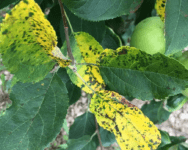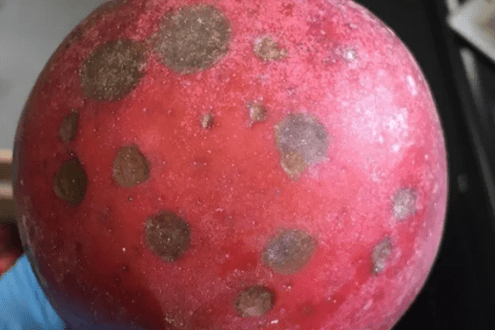Sep 8, 2022Continue to manage fruit rot, even after harvest
Apple harvest is well underway in Pennsylvania and Maryland, and with attention shifting to getting fruit off the tree, folks might think the sprayers can be put away.
The first part of September has turned out quite warm and soggy, which are prime conditions for tree fruit pathogens to thrive. Considering we have received several inches of rain this week, this is a reminder that any fungicides that had been applied need to be reapplied, especially since we are in the harvest season. Fruits are still susceptible to fruit rots and sooty blotch, and flyspeck.
Marssonina blotch is another disease that favors wet conditions. Marssonina blotch can defoliate trees quickly and, if pressure is high, potentially cause fruit issues in storage. It is important that growers remain vigilant and keep fruit covered with fungicides during the harvest period. This is especially important for later harvested varieties and varieties intended to be kept in long-term storage.
Preventing pre-, postharvest apple fruit rots
Controlling for preharvest apple rots is critical; however, fungal spores are stealthy and can hitch a ride on apples without causing symptoms, giving growers a false sense that picked fruit are clean. During storage, those fungi will wreak havoc and cause fruit to decay. Growers need to be thinking about the durability of their final fungicide sprays, especially when large amounts of rain have fallen. It is also important to be thinking about those late-season cultivars that may not be harvested until October or early November. Additional fungicide sprays will be needed for those cultivars in late September or even October, depending on our conditions. This is especially important for any cultivars that will be in cold storage for more than one month.
Since bitter rot has been the primary concern for the last few years, our research has shown that conventional fungicides vary in efficacy. It is important to note that our preliminary research about postharvest rots in the Mid-Atlantic is showing Alternaria rot, a disease that begins in the field, is a very important rot occurring during storage.
In addition to applying fungicides, some general management techniques to keep in mind to reduce postharvest fruit rots:
- Should rotting fruit be encountered within the tree during harvest, drop fruit to the ground. This will limit disease spread within the canopy and contamination of fruit that may be picked later.
- The more mature a fruit, the more susceptible it is to storage diseases. Harvest fruit at proper maturity.
- Bruised or wounded fruit are susceptible to postharvest fruit rots, such as blue mold and gray mold. While harvesting, handle fruit carefully when picking and transferring fruit from bag to bin to avoid bruising or wounding.
- Inoculum sources for rot pathogens causing disease in storage (if already not hitching a ride on the fruit) come from plant and soil debris. Use clean bins and minimize the amount of soil and plant debris brought in on bins.
- Warm temperatures encourage pathogens to grow. Keep fruit cool after harvest, i.e., keep bins in shade.
- If delivering to a packinghouse, minimize the time between harvest and delivery of fruit.
Managing Marssonina blotch


Marssonina blotch (or apple blotch) symptoms are quite widespread in the region. Leaf spots first appear on the upper surface of mature leaves in late summer. They are 5-10 mm in diameter, grayish, brown, and tinged purple at the periphery. Small black acervuli (small asexual fungal fruiting bodies) are often visible on the surface. When lesions are numerous, they coalesce and the surrounding tissue turns yellow, resulting in defoliation.
If the infection is severe, the entire tree can lose its leaves in a short period of time. In addition, fruit can become infected, and symptoms may be evident before harvest or during storage. Symptoms appear as small, black sunken lesions. The lesion is firm; more than one lesion may be on the fruit. Products used to manage fruit rots will also manage Marssonina blotch. It is important fungicides are reapplied after rain events.
Managing sooty blotch and flyspeck
Sooty blotch and flyspeck are summer diseases that can cause headaches for apple growers since they lower fruit quality and market value. Sooty blotch and flyspeck also shorten fruit storage life because of increased water loss. New infections can be observed as late as September.
—Kari Peter, Penn State Extension, associate research professor, tree fruit pathology
TOP PHOTO: Don’t let apples harvested in October or November look like this Apply fungicides timely late in the season to protect fruit from rots. PHOTO: Kari Peter
BOTTOM PHOTO: Marssonina is widespread in many orchards. Limit defoliation with regular fungicide sprays during late summer. Photo: Kari Peter















